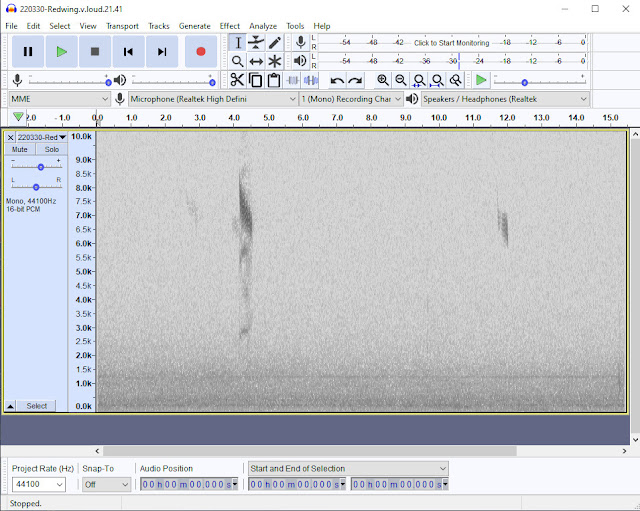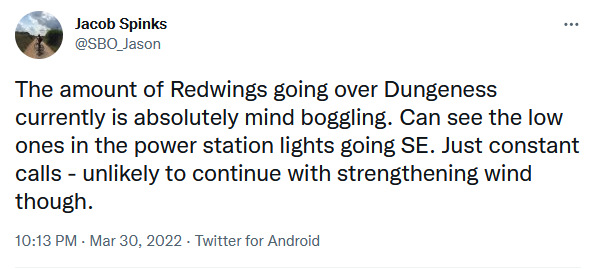The nocmig kit has been out almost every night this month, plus 13 nights in February (from 6th) and Redwing has featured on most. Usually single-figures, but a good count of 76 on 2nd/3rd March, which more than doubled the 2021 spring peak of 30 on March 20th/21st. Still, nothing outlandish. On Twitter last night I noticed this from Jacob Spinks, assistant warden at Dungeness Bird Observatory...
A big movement of Redwings in SE Kent is hardly something I would expect to be mirrored in W Dorset, but, well...
Reviewing last night's nocmig, it was obvious that Redwings were on the move. By 21:00 I'd counted 12, by 22:00, another 93. And then it all kicked off, with 261 between 22:00 and 23:00, before drying up very quickly thereafter - just another 15 all night. In my experience so far, 381 is an exceptional Redwing count for spring.

|
|
A screenshot straight off my laptop. Exactly 28 seconds (from just
before 22:30) and there are 11 Redwing calls visible there,
ranging from pretty loud to almost inaudible. |
The screenshot above illustrates what I would say is a typical bunch of Redwing calls. The screenshot below illustrates a very rare event: a Redwing appears to be screeching directly into the microphone from about two inches away...

|
| Yes, that is a Redwing at 4sec. A rather loud one. |
As we all know, Redwings utter a high-pitched note as they pass overhead at night, a familiar sound to those of us whose ears haven't quite given out yet. However, what the sonogram clearly shows is that there are some quite strong lower-pitched elements to this call also. I am pretty sure I've never recorded such a loud call before, so this was news to me. And here is what it sounds like...
Pretty cool, eh?
Of course, all this unexpected Redwing activity poses a load of questions that I can't answer. For example, there have been very few Redwings around locally, so where were they from? From the Continent? Well, if so, how come the first few were passing over so soon after dusk? I thought it interesting that the Dungeness birds appeared to be heading SE accross the Channel. Were the Bridport birds doing likewise? If so, why? Were they aware of the impending northerly weather, and responding to some urge to flee from it? Or maybe they were from south-west of us (Devon?) and coasting rather than heading north, again because of the imminent weather? If none of the above, then what? Etc, etc...
All good fun.

Doesn't it seem odd that redwings would flee an oncoming cold front to return to a colder climate?
ReplyDeleteI strongly suspect that their sudden appearance in numbers was something to do with the weather, and I doubt they'd be keen to fly into the teeth of a cold northerly, but beyond that I have no idea really.
DeleteVery interesting. Here on Skye there have been essentially no Redwings all winter, then quite a few a week back followed another pulse today. I presumed these would be Icelandic birds heading north to their breding grounds, but maybe I have that all backwards and they are heading south and away from the snows that have hit us this week (heard only - I've been working indoors today). Can you deduce direction at all from your nocmig kit, or would you need at least two synchronised mics to figure that out?
ReplyDeleteCheers Seth, that's an interesting coincidence. I record with single mic,so unfortunately cannot figure out direction of flight, but I'm not sure I could reliably tell even with two mics pointing in different directions. Perhaps when thermal imaging cameras come down in price...?
Delete